
What Is A Hard Dodger? (And How To Build One)

Last Updated by
Jacob Collier
August 30, 2022
When sailing on your boat, you might come across undesirable wet conditions. Since you are on the water, you will likely be wet unless you have a hard dodger.
Staying dry while sailing is a tough task to accomplish, but it is possible. How would a hard dodger help and how do you build one?
Hard dodgers are enclosed structures protecting you and the cockpit from the elements. With this added protection, you are keeping yourself comfortable, electronics safe, and companionways dry. Building one is much cheaper than purchasing, but will also cost you time and patience.
Building a hard dodger should not be a task that is rushed, as you need to allow time for things to mold and take shape. If you are interested in building a hard dodger, you will see the importance and why it is essential for everyday sailing.
According to boaters university, sailing with a hard top dodger significantly improved the experience. No matter your sailing experience, having a hard top dodger makes the process efficient and more enjoyable.
Table of contents

Basics of a Hard Dodger
There are two different types of dodgers, with one being soft and the other hard. Soft dodgers are typically made up of canvas or vinyl, but these are temporary or used on an as needed basis.
Hard dodgers are meant to be permanent and cost more money up front. The enclosed shell surrounding the cockpit, along with the laminated glass windows, protects your boat and offers a clear view for many years.
Benefits of a Hard Dodger
These dodgers offer the best combination of safety, comfort, and reliability. When sailing, you want to have the best of all three worlds and you want to protect your investment.
Protection Against All Conditions
Hard dodgers offer protection to the cockpit and companionways during inclement weather, high wind, or rough waves. Being protected by a hard dodger will be more comfortable during those situations, especially since you can hide under the hardcover.
Since you are underneath a hard dodger, you will be protected from the sun's rays as they will bounce off the top. As for soft dodgers, these will deteriorate over time with the harsh sun beating down on it, so you will be replacing these every so often if you do not remove them after each use.
Perfect View
Since the cockpit is enclosed and typically used laminated glass, you will have unobstructed views when sailing. In most soft dodgers, your view will be blocked by patches of canvas.
For hard dodgers that use laminated glass, these surfaces are easy to clean. If any mold or mildew attempts to form, it can easily be removed within a few seconds and you are back to clear views.
Reliability
The structure of a hard dodger will offer many benefits for years to come. For example, the structure will serve its primary purpose to protect from weather or rough waves, but it also includes secure handholds to safely step down into the cockpit or when exiting.
In addition, it also provides temporary shelter when riding out tough waves or storms. Getting caught out in a situation when you do not have any dodger is bad enough, but a hard dodger can make rough situations more tolerable.
How Much Does a Hard Dodger Cost?
There are not a lot of hard dodger kits for sale online. Instead, you would need to contact a company that builds them specifically for your boat or do one yourself.
Some websites offer kits for soft dodgers that require a special sewing machine . However, you can see how much money you need to spend just for fancy fabric that you will likely need to replace over time.
When it comes to hard dodgers, doing it yourself will save you tons of money over the long haul. Depending on the size of your boat and the materials that you use, you will be spending anywhere between $2,000 and up.
The reason there is not a price cap is because you can essentially add anything to a hard dodger and use about any materials necessary to get the job done. For a rough estimate, expect to spend around $10,000 on average to have good quality for the long term.
To put this in perspective, you might not want a hard dodger if your boat is relatively cheaper. If you have a $100,000 sailboat, or simply want to improve the value of your current one, it might make sense to protect your investment with a hard dodger.
How to Build a Hard Dodger
To begin the process, it would be best to have a cardboard prototype with measurements of your hard dodger that you want to make. If you have an old dodger handy or something of relevance to the size you need, that is a great start.
Having measurements and something to go by is great, especially since you do not want to obstruct your view of the helm. You also want to allow room for movement in the cockpit and navigating in or out of it.
Making the Shell
Use cardboard or something you can easily bend and cut to help make your mold. You will also need tape and something easily bendable with the use of a heat gun like pvc water pipe for mounting points.
Once you have made the shell, simply apply it to your boat and view from all angles. This way you can see how the rough draft will apply in real time and to get a better picture of things to come.
Cut Plywood
Once you are happy with the shape of your mold, it is time to apply that to the shape of plywood. You can use heavy duty marine grade ⅜ inch plywood or regular construction grade.
If you use marine grade, it will stand up to water better if it ever gets wet. However, it is harder to bend and regular construction grade could work just as well.
Once you have made the cut to your plywood, you should test the fit to make sure it works. Simply make adjustments as needed.
Make Bending Frame
Now is the time to make a bending frame for the plywood core. You could use two 2x12 wooden planks with cross pieces that screw on. The planks should be spaced out roughly a third of the width of the dodger, or your fore-aft distance.
It is important to note that you need a leveler and measuring tape to properly check the cuts. Anything that is off just the slightest could result in a warped or bent dodger when the final product is bolted down.
Cut along the profile of the dodger’s bend into two sections of plywood. You will need to screw in the contour pieces to the planks.
You will also need to cut roughly a dozen or so blocks, but do not need all of them, to help stabilize the dodger core. These could be something like 3x3x1, which you will use to evenly distribute along the contour.
Make a mark that will be easy to see when identifying your center line. This will be useful when bolting everything down when applying the core to the frame.
Now you can apply the core to your frame to see if everything fits. When aligning the center of the core to the contour, make sure you can apply enough pressure to allow it to conform.
Once everything is in line, you can screw the core to the frame. Using your center line from earlier, you can easily see the midline of the core and the midline of the frame.
Apply Dodger to Boat
Once you have built the dodger frame, you can now test it out on your boat. Carefully move the completed frame over to your boat and align accordingly.
Bolt down the dodger to the boat with the aligned holes. After bolting down the dodger, make sure you have everything in line before you attempt to do anything else.
You have two options to consider at this point for the next step. You can either remove the dodger from the boat to finish the process in another location or leave it and do all the work from the boat. Keep in mind that leaving it on the boat will require you to work entirely from the boat for the next several days or longer.
Once you have completed installing your dodger and any additional panels that you see fit, you can move onto the clean up process that will add longevity to the dodger. If there are any small gaps, this is not a big deal assuming it does not interfere with the integrity of your structure.
If you have small holes or gaps, this can be filled later with epoxy or wood filler. Keep in mind that you want something that is going to be easy to sand. You are going to want a smooth surface later to apply a coat of sealant and paint.
In addition, look for areas along edges to apply fiberglass tape, epoxy, and edge reinforcements. This will make the finishing process easier and give it a cleaner look while also stabilizing the frame.
Additional Features
Before you begin adding glass and sealant to your hard dodger, this is a great time to add any additional features such as speakers, opening hatches, solar panels, or anything you desire. Now that you have the frame in place to your liking, it is easier to add these features than after it is completed.
You do not have to have everything a perfectly snug fit. This will all be covered later in the clean up process, so do not stress over small gaps.
If you see an opportunity to make holes bigger for electronics or other features, now is the time to do so. You will have plenty of opportunity to fill everything with paint and epoxy later.
Adding Fiberglass
With the dodger perfectly in place, now is the time to add fiberglass. You should install temporary support systems to avoid any shape distortions wherever you are going to place the fiberglass. This is as simple as using tape, cloth, and your favorite epoxy.
Once you have installed the fiberglass, you need to make sure every corner or gap is filled. Simply continue to use epoxy in places where it is needed and remember that you can sand any excess later.
Sanding, Painting, and Applying Dodger
One of the most rewarding steps is to clean up the dodger. All of the love labor you have poured into this project now gets the flavor to suit your taste.
Finish sanding down the dodger and clean up any areas to provide a smooth surface. You also need to make sure there are not any unlevel spots, so using a fair compound to fill in these areas will need time to cure and sand later.
After you have sanded to perfection, you can paint the dodger to any color of your liking. For simplicity, most people stick to white.
The paint will need to be either an oil-based rust-proof paint or a single-component polyurethane. Whichever one you choose, you need to continue using that specific application or it will not stick properly over time. If you do not like that particular application, you would need to sand it all off and start again.
The easiest to use is an oil-based paint that is marine grade, or at least stands tough in water. This paint also works well when you want to apply a thing coat to give your dodger a fresh look over time.
If you have intentions of standing on top of your dodger, it would be wise to add some form of non-skid. This could be crushed walnut shells or sand over several coats of paint. Without non-skid, your dodger top will be like ice if you plan to step on it.
Once everything is painted, you can add the dodger to your boat if you had chosen to work at another location. Whether you are bolting it down now or previously in the process, make sure your bolts are heavy duty and rated for rough conditions.
Related Articles
Born into a family of sailing enthusiasts, words like “ballast” and “jibing” were often a part of dinner conversations. These days Jacob sails a Hallberg-Rassy 44, having covered almost 6000 NM. While he’s made several voyages, his favorite one is the trip from California to Hawaii as it was his first fully independent voyage.
by this author
Repairs and Maintenance
Most Recent

What Does "Sailing By The Lee" Mean?
Daniel Wade
October 3, 2023

The Best Sailing Schools And Programs: Reviews & Ratings
September 26, 2023
Important Legal Info
Lifeofsailing.com is a participant in the Amazon Services LLC Associates Program, an affiliate advertising program designed to provide a means for sites to earn advertising fees by advertising and linking to Amazon. This site also participates in other affiliate programs and is compensated for referring traffic and business to these companies.
Similar Posts

How To Choose The Right Sailing Instructor
August 16, 2023

Cost To Sail Around The World
May 16, 2023

Small Sailboat Sizes: A Complete Guide
October 30, 2022
Popular Posts

Best Liveaboard Catamaran Sailboats
December 28, 2023

Can a Novice Sail Around the World?
Elizabeth O'Malley
June 15, 2022

4 Best Electric Outboard Motors

How Long Did It Take The Vikings To Sail To England?

10 Best Sailboat Brands (And Why)
December 20, 2023

7 Best Places To Liveaboard A Sailboat
Get the best sailing content.
Top Rated Posts
Lifeofsailing.com is a participant in the Amazon Services LLC Associates Program, an affiliate advertising program designed to provide a means for sites to earn advertising fees by advertising and linking to Amazon. This site also participates in other affiliate programs and is compensated for referring traffic and business to these companies. (866) 342-SAIL
© 2024 Life of Sailing Email: [email protected] Address: 11816 Inwood Rd #3024 Dallas, TX 75244 Disclaimer Privacy Policy

- Forums New posts Unanswered threads Register Top Posts Email
- What's new New posts New Posts (legacy) Latest activity New media
- Media New media New comments
- Boat Info Downloads Weekly Quiz Topic FAQ 10000boatnames.com
- Classifieds Sell Your Boat Used Gear for Sale
- Parts General Marine Parts Hunter Beneteau Catalina MacGregor Oday
- Help Terms of Use Monday Mail Subscribe Monday Mail Unsubscribe
Building a custom hard dodger
- Thread starter flightlead404
- Start date Mar 29, 2022
- Hunter Owner Forums
flightlead404
- Raise the dodger slightly and bring it slightly further back
- Include both fixed and opening lexan/plexi windows on the front and sides
- Add high and how grab bars to the sides
- Some sort of mechanism to attach a sunbrella/eisenglass connector from dodger to bimini that doesn't leak rain
- Rain gutter or shape it to guide rain to the sides away from companionway
- Be lightweight
- Be removable
- Be not unattractive
Interesting concept. I am familiar with the construction of the EZ's and Velocities. Obviously, this is an airworthy construction technique, and is very strong. The rigidity of the wing, I believe, comes from the thickness at the chord. Do you know how thick your sides and roof will have to be? Also, this type of construction was not impervious to moisture intrusion. Timely inspection of the wings for moisture content was required, and I saw one EZ that was in the process of having a wing refoamed and reglassed.
Tom J said: Interesting concept. I am familiar with the construction of the EZ's and Velocities. Obviously, this is an airworthy construction technique, and is very strong. The rigidity of the wing, I believe, comes from the thickness at the chord. Do you know how thick your sides and roof will have to be? Also, this type of construction was not impervious to moisture intrusion. Timely inspection of the wings for moisture content was required, and I saw one EZ that was in the process of having a wing refoamed and reglassed. Click to expand
Guy on this site built one for a H40: Repairing Hunter 40 damage from Hurricane Matthew Materials were plywood, rigid foam board, and fiberglass. Most of the shopping list can be found at big box lumber store. I think your biggest design challenge will be: removable - the tolerances needed to make it securely attached without wiggle and the potential for wear. Also making a fastening system that is removable but strong enough to support people or getting pooped by the occasional wave might be a challenge. attractive - most of the DIY hard dodgers I see are boxy and look like the cockpit of the millennium falcon. Not my aesthetic.
kbgunn said: Guy on this site built one for a H40: Repairing Hunter 40 damage from Hurricane Matthew Materials were plywood, rigid foam board, and fiberglass. Most of the shopping list can be found at big box lumber store. I think your biggest design challenge will be: removable - the tolerances needed to make it securely attached without wiggle and the potential for wear. Also making a fastening system that is removable but strong enough to support people or getting pooped by the occasional wave might be a challenge. attractive - most of the DIY hard dodgers I see are boxy and look like the cockpit of the millennium falcon. Not my aesthetic. Click to expand
Did you ever build that hard dodger?
MNF said: Did you ever build that hard dodger? Click to expand
This site can do all of those, but the cost of Canvas is unstable for now Bimini, pre-measured Jim...
flightlead404 said: no I worked with a local shop to make some design changes and then had them build a dodger, Bimini and connector which I can build some side panels for to make a full enclosure Click to expand
The bimini and, to a lesser extent, dodger on our 2002 Hunter 466 are also on their last legs. We have been getting more a more solar panels (4 x 100 flexible at the moment) and have been thinking about replacing the canvas b&d with something rigid so that panels could be more or less permanent. The big issue is making something that fits the existing frame (I've read that that the framing is the most expensive part of this design) and looks good. Has anyone considered using the existing canvas as a "mould" to create the new b&d? Maybe applying some kind of barrier (duct tape) to the existing canvas then applying layers of FG to make a rigid surface, removing the FG product, gel coating it and then affix fasteners. Then the new one would be a nice shape.
PatAndEuan said: The bimini and, to a lesser extent, dodger on our 2002 Hunter 466 are also on their last legs. We have been getting more a more solar panels (4 x 100 flexible at the moment) and have been thinking about replacing the canvas b&d with something rigid so that panels could be more or less permanent. The big issue is making something that fits the existing frame (I've read that that the framing is the most expensive part of this design) and looks good. Has anyone considered using the existing canvas as a "mould" to create the new b&d? Maybe applying some kind of barrier (duct tape) to the existing canvas then applying layers of FG to make a rigid surface, removing the FG product, gel coating it and then affix fasteners. Then the new one would be a nice shape. Click to expand
- This site uses cookies to help personalise content, tailor your experience and to keep you logged in if you register. By continuing to use this site, you are consenting to our use of cookies. Accept Learn more…
hardtop dodgers and biminis
A little history: tartarooga goes back to 1977, Jacques built the first hardtop dodger for his sailboat. It was a Dragon Class sloop, a sleek racer. The purpose was to keep the boat’s dog, Mister Eddy, out of rain and spray.
The first incarnation of our hardtop dodger became quite popular among Dragon racers. It essentially consisted of a hard top salvaged off an 1959 MG-A roadster. The rear window was now facing forward, pretending to be a windshield. Mister Eddy stayed dry. Everybody and their cousins decided that they needed a dodger “just like that one”.
By mid-1978, Jacques had bought all the junkyards out of hard tops. There were only two choices, quit making hardtop dodgers, or manufacture them from scratch. – more below –

In 1983, Jacques went into business, starting his own custom boat building company. What became known as the Samish River Boat Shop built a number of one-offs. Up to 42′ in length, to the most exacting standards of engineering, aesthetics and finish.
Bea became our resident Sail- and Canvas maker from day one. She produced sail inventories and canvas items of all descriptions. Her workmanship and dedication to detail are unsurpassed by anyone in the industry. Everything coming from her shop is extremely well thought out and finished. She has participated in the completion of over 600 tartarooga Hard Dodgers.
The first commercially sold hard dodger, under the tartarooga label, was installed in 1983. With every dodger made, we have improved on the concept and refined details. Today tartarooga can be viewed as a truly mature product, often copied, but unmatched by anyone.
Our Main Goals are Seaworthiness and Seakindliness
When you put to sea in a boat, you will be exposed alternatively to hot or cold. There will be calm or stormy conditions, with rain and spray.
It is our declared purpose to provide optimal protection from these extreme conditions. Our structures are so strong you can depend on them in any kind of sea conditions. With our products your entire crew will arrive in port feeling fresh and rested. (See below)
Our Products
tartarooga hardtops are hand laid-up in our proprietary molds, using high-tech materials.
tartarooga Hard Dodgers and Biminis have integral structural members and downturned edges fore- and aft.
tartarooga means engineered for ultimate strength and impact resistance, while keeping weight low.
tartarooga Hard Dodgers come with stainless steel frame and a pair of lateral handrails.
tartarooga tops have a finish of high-grade marine gelcoat, inside- and out.
tartarooga Hard Dodger windshields will release, under pressure, to yield to possible wave impact. (see report below)
tartarooga products are fabricated with canvas of the well-known SUNBRELLA or TEMPOTEST brands.
tartarooga windows are made of STRATAGLASS ™ or TUFFEK ™.
All tartarooga canvas work is sewn with UV-proof TENARA ™ thread.
Experience TARTAROOGA at Sea!
Hi there! It’s Lee Youngblood. – I thought we try to track you down to say thank you, thank you! Thank you very much for a wonderful job! – Hum, we hit a stack in the middle of the night. It dropped – uh – several tons of water on us. I think the whole boat shuddered to a stop. Most of it went between the mast and the cockpit. And, – uh – blew the windows out of the dodger. And filled the cockpit to about 4 inches below the top of the coaming. And, – uh – John stuck his head up and asked “are you still here?” I said “yeah! everything OK!” – hum – I asked “can we do anything about the windows?” “Just snap them back up! Jacques said they’re supposed to blow out when hit by green water”. So, I just wanted to say thank you for a great dodger! (Transcript from our voice mail)
Explanation: our hard dodgers incorporate an added feature that allows the windshield to release under pressure when impacted by a massive amount of water. This prevents the dodger from getting torn away by a surge of green water on deck. When the water has drained away, the windscreen can be “snapped back up”.
Thinking about new cushions?
Please provide details below. We are happy to help!
- Total number of cushions *
- What type of cushion project * MARINE RESIDENTIAL COMMERCIAL OTHER
- Cushion Application Details * Please give a brief description of your cushion project
- General Dimensions * Please provide your best general dimensions including the thickness. Note any shapes or angles. Measurements do not have to be exact at this point.
- What thickness do you want your cushions? Cushions are typically 1"- 6" thick but can be custom thickness.
- Cushion Fabrication * Please select... Recovering existing cushions Making new from scratch and need new foam Need repairs Need a new foam insert only Choose one
- Fabric * Please select... I have not chosen fabric I will provide my own fabric I have chosen my fabric
- Special shape or cut-out
- Snap pockets or other hardware
- Breathable underling
- Beveled shape
- Striped fabric
- Providing my own fabric
- Templating and travel * Please select... I will provide final dimensions myself I will send you my own template I will bring my project to the shop to copy You need to travel to my location to template I don't know at this point Please choose one
- My project deadline is
- Notes or Comments Please provide any additional relevant information that may help us with the estimate.
- Photos Drop files here or Select files Accepted file types: jpg, gif, png, pdf, Max. file size: 50 MB. empty to support CSS :empty selector. --> Please provide photos. They are very helpful.
- How did you hear about us? * Please select... Word of mouth Local business Google search Yelp or Bing Local event Employee Returning customer Friend Publication Facebook Van Logo
- Email This field is for validation purposes and should be left unchanged.
General Inquiries pop up
Have a question.
Get in Touch:
- What is your project or question for? * MARINE RESIDENTIAL COMMERCIAL OTHER Other like Automotive, Military, Government, Education
- General question or project description: *
- Attach photos here: Drop files here or Select files Max. file size: 50 MB. empty to support CSS :empty selector. -->
- Comments This field is for validation purposes and should be left unchanged.

HARDTOP DODGERS
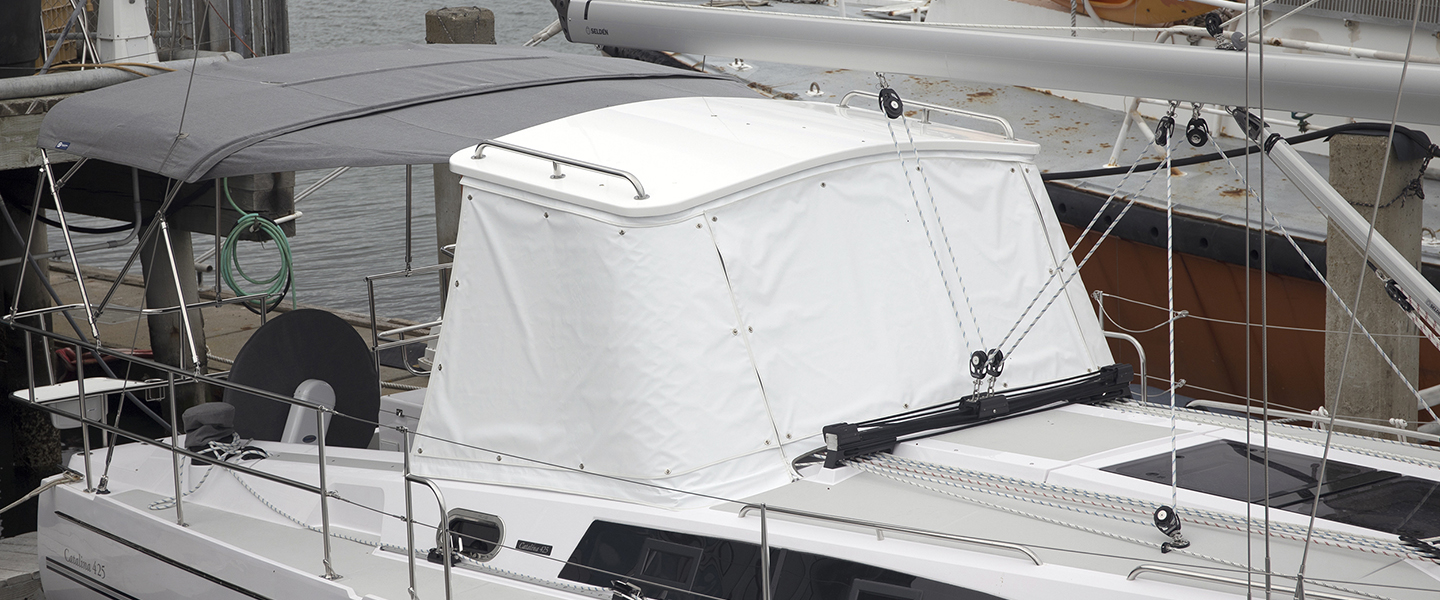
Hardtop Dodgers
Hardtop Dodgers are a perfect choice for a better offshore experience. The Canvas Works fabricates custom, world-class hardtop dodgers. Sailboats with hardtop dodgers have many benefits because the combination of the rigid top with the fabric and vinyl enclosure gives the most versatility and protection. For details, view our Hardtop Dodger Tech Flyer .
The Benefits of the Hardtop Dodger:
- A dependable structure for peace of mind when cruising offshore
- A strong, robust and durable surface to mount solar panels or hardware
- A low maintenance support structure to withstand harsh cruising conditions
- A smooth, cleanable surface that won’t tear, mold or stretch
- A sleek, rigid enclosure that provides ultimate protection from wind and rain
The Dodger Design
We have designed our hardtop dodger with both form and function in mind. As a result, the hardtop provides unparalleled protection from the elements and offers a safe, rigid platform to mount accessories and hardware for offshore and coastal cruising.
The Dodger Enclosure
The enclosure for the hardtop is attached with careful consideration to your specific boat and your needs as a sailor. Our experienced team attaches the enclosure to the hardtop with track, zippers and stainless steel stanchions. The dodger windows are framed in your choice of Sunbrella or Stamoid and sewn together with Teflon thread for durability and strength. In addition to choosing the configuration of your windows, we guide you on the height and angle of your structure.
Hardtop Dodger Specifications:
- Rigid Top: ¾” foam core, x-mat glass, and high-quality Gelcoat. Cambered 90” x 54” x 1” with rain lip.
- Support System: 1-1/4” 316 stainless steel stanchions and supports
- Handrails: top, bottom, and sides
- Boat: currently available for 38′-46′ sailboats
- Windows: Fitted 40 mil clear view polycarbonate. Lexan can be rolled. Makrolon is rigid.
- Frame: Stamoid or Sunbrella double-sided fabric frames with reinforcement
- Hardware: Keder cord and rail if applicable; Lift-A-Dots or Common Sense also available
If you are in the market for new Hardtop Dodger, call The Canvas Works @ 415.331.6527 or inquire now .
Get an Estimate
View Our Gallery of Diverse Canvas Projects

- Call 415.331.6527
- Email [email protected]
- Location The Canvas Works 41c Liberty Ship Way Sausalito, CA 94965

Attainable Adventure Cruising
The Offshore Voyaging Reference Site
- How To Home Build a Hard Dodger For an Offshore Sailboat
After reading about our dodger , very experienced live aboard voyagers Lane and Kay Finley sent along a detailed description of their hard dodger, complete with photographs. The advantage of theirs over ours is that it is all hard with glass windows; much stronger and pretty much maintenance free. On the other hand, I like the larger expanse of window, fewer blind spots and curved shape of ours. Just goes to show that everything on a boat is a compromise.
Many thanks to the Finleys for sharing the information below:
In the end, we designed and built our own hard top, using foam-cored fiberglass construction to achieve strength and lightness. The finished project is strong, safe to stand on, gives excellent visibility through glass , doesn’t ruin the lines of the boat and provides amazing protection from the weather.
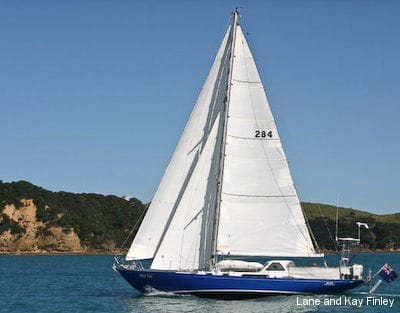
Our navigation electronics now live under the hard dodger where they are protected from the elements and much more user friendly. We have also noticed that we get less ‘salt air’ inside the cabin.
Before undertaking this project, we took pictures of dozens of hard dodgers on boats that we saw sailing in New Zealand waters. The New Zealanders are well aware of the benefits and you can see all sorts of creative designs in every port.
Since we consider our Annapolis 44 to have fairly elegant lines we were very cautious to adhere to a complementary design. After many drafts, we finally drew the final design to scale and then lofted the plans on our garage floor. We built the mould out of MDF plywood with inserts for the windows so that the 10mm safety glass would end up being set-in against a solid fiberglass lip and be flush with the exterior surface of the hard top.
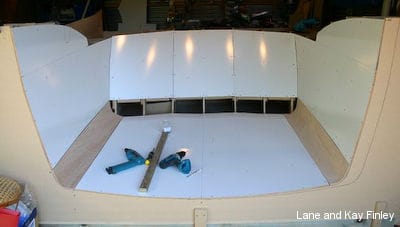
This was a ‘female’ mould, so the interior surface was sanded smooth and then waxed to prevent the fiberglass resins from sticking to the mould. We laid up the required layers of fiberglass cloth and resin in the mould, and then placed the foam core (30mm medium density) over the fiberglass layers. At this point we laid up more fiberglass to the design specifications and ‘sandwiched’ the foam in place.
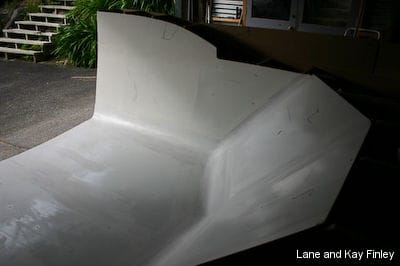
High Modulus, a composite engineering company in Auckland, made some recommendations for the engineering specifications.
The finished product, which also includes a dome light and reading lights in the ceiling, was fibreglassed in place and we re-painted the deck to finish it off. It has proven to be an excellent addition to the boat and cost approximately US$3000 in materials to build. Of course that does not count our labour. However, it was an interesting winter project and one that we are very proud of.
Please Share a Link:
More Articles From Cockpit Enclosures and Dodgers:
- Cockpit Dodger For an Offshore Sailboat
- A Sailor’s Cockpit Enclosure—Part 1
- A Sailor’s Cockpit Enclosure—Part 2
We are venturing out on our first cruise at the end of this year. San Diego to Annapolis VIA Panama Canal BVI. I am considering a hard dodger, but am probably going to do the work myself due to quality craftsmanship, and design. Any pics and instructions explaining your process would be a real help. I truely believe there is a growing interest in hard dodger design and home fabrication. You’d surely get internet traffic if you posted your process. Thanks in advance. Darrell
Hi Darrell, I guess I feel like Lane and Kaye have already given some pretty good information on how to build a dodger in this post. That is probably about as far as we or them can go for free. (Internet traffic does not put food on the table.)
I would recommend that if you want a detailed design as well as specification for the materials that you contact Ed Joy . Not only will you learn how to build the dodger from him, you will also get a dodger that fits the lines of your boat and enhances her resale value.
I built a hard dodger for Jenain, my steel Ebbtide 36, a few years ago. I used commercial Hexacor g.r.p panels, which are cored with cored with pvc honey comb, 10mm tempered glass for the fixed windows and 12mm polycarbonate for the opening window. I built it using the stitch and glue technique and West Epoxy. In my case, it has to be removable as I could otherwise not remove the engine. This was an easy project, finished in two weeks, and very strong, good looking and practical. Off course in hind sight, it could be improved on, by moulding in wire conduits for example, but overall I am very happy with it. It provides great protection, is light, and compliments the boat’s lines. I have a lot of photos if anyone is interested.
That sounds like a great way to build a hard dodger and much easier than building a mold. Thanks for sharing your experence. Also, really good point about the importance of being able to remove the dodger to get the engine out of most sailboats.
I know what you mean about hindsight improvements, I made exactly the same omission!
hey bill i would be interested in some pictures of your dodger. i have a goderich 37 ‘ steel hull (libro vent), and i need to get her ready for travel. thanks jonathan miller
hey bill i would like to see some pictures of your dodger. i have a 37′ steel hull (libro vent). i need to get her ready for travel. thanks jonathan
If it ever stops snowing, I am going to replace my Sunbrella covered dodger and bimini with something rigid. I would love to see some detail pics of your stitch and glue technique with the Hexicore also how you deal with the edges. Sounds like the best way to go.
Hi Jonothan, send me your email address, and I will send you the photos. My email address is moc.oohay@9991nianej . Bill Robinson.
I too would appreciate pictures. Here in Alaska my Formosa 46 could use a hard cover for snow and cold protection. If available, please send pics to: moc.cam@yalcateb Thanks, Clay
Would you send me some picture as well? I’d like to make one for my pocket cruiser S2 9.2c sounds like a good way to go. Captain Den
If I had your email address, I could send you the info!
Hi Bill. Would you be kind enought to send me some pictures of your hard dodger. My email is: moc.liamg@asnik.ys With thanks in advance, Bill Attwood
Bill, please send pics of your dodger. Thank you.
Hi Bill, Please send pics of your dodger Thank you, Ed Rudetsky
Hello bill, Could you please send me your dodger pictures? Clive @ earrame.net Thanks in advance.
Hello Bill, Another request for dodger pictures! Would love to build one for my Niagara 35. Thanks in advance for sharing the photos.
Regards, Barry
This is a very old post and thread. Also since this is not a forum, but rather comments to post in WordPress, Bill is not being informed of your request, so I don’t think this is going to work for you.
I am building a hard dodger for an O’Day 35, I want to move the traveler from the deck forward of the companionway to the aft end of the dodger–out of the way. The main arch at the very rear which will be the load bearing part, has a base (entire top ) of 1/2″ cell modulus (NICORE) with one layer of fiberglass matting on the bottom and three on top, laminated. In addition, across the top inside will be two beams two feet apart and 65″ wide made of six 2″ strips of 1/4″ plywood laminated into a curve with an apogee of 6″. On the sides in the area of the traveler there will be a 1/2″ aluminum plate bolted to the side just above the deck with a straight piece of the laminated plywood connecting to the top beam with bolts, a 10″ x 10″ gusset and a aluminum “T” bar where the “T” is 1 full inch as is the cross part. This will be screwed to the wood piece and then the outer part. will accept the side structure on top of the aluminum plate and inserted into the notch in the aluminum upright that is connected to the wood upright. The sides will be a layer of fiberglass with under a 1/2 ” piece of Nicor and two or more layers of fiberglass inside. I’m going to make a deck casting out of fiberglass to mount the sides in and the whole thing will be smoothed and faired with more fiberglass, resin, etc. the casting will ne bolted to the deck. I don’t need to go further since the question is: Do you think this construction will be sufficient to handle the load of the traveler and it’s sheet?
I started to answer this, but it got long and ended up being an article. Look for it in a week or so.
Hello Denny
It’s not clear to me whether the hard dodger will be removable. Regardless, if ever you plan to move the boat via road, a non-removable dodger may not meet height restrictions. I recently had to remove an arch and all stanchions when transporting my Niagara 35. Barry
- New Sailboats
- Sailboats 21-30ft
- Sailboats 31-35ft
- Sailboats 36-40ft
- Sailboats Over 40ft
- Sailboats Under 21feet
- used_sailboats
- Apps and Computer Programs
- Communications
- Fishfinders
- Handheld Electronics
- Plotters MFDS Rradar
- Wind, Speed & Depth Instruments
- Anchoring Mooring
- Running Rigging
- Sails Canvas
- Standing Rigging
- Diesel Engines
- Off Grid Energy
- Cleaning Waxing
- DIY Projects
- Repair, Tools & Materials
- Spare Parts
- Tools & Gadgets
- Cabin Comfort
- Ventilation
- Footwear Apparel
- Foul Weather Gear
- Mailport & PS Advisor
- Inside Practical Sailor Blog
- Activate My Web Access
- Reset Password
- Customer Service

- Free Newsletter

How to Perform Your Own Pre-Buy Inspection
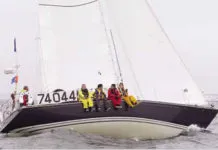
C&C 40 Used Boat Review
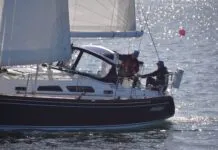
Sabre 386 Used Boat Review
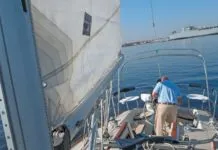
What You Can Learn on a Quick Test Sail


Preparing Yourself for Solo Sailing

Your New Feature-Packed VHF Radio

Preparing A Boat to Sail Solo

Solar Panels: Go Rigid If You have the Space…

Ground Tackle Inspection Tips

Shoe Goo II Excels for Quick Sail Repairs

When Should We Retire Dyneema Stays and Running Rigging?

Rethinking MOB Prevention

Is It Time to Get an Electric Dinghy Motor?
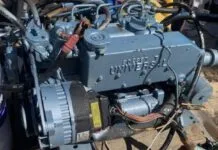
Worship Your Universal M-Series Diesel With the Marinized Kubota Block

Taking Care of Your 12-Volt Lead-Acid Battery Bank

Hassle-free Pumpouts

Battle of the Teak Cleaners — Snappy Teak-Nu vs. Star Brite

New Seacocks for the Offshore Sailor

Bottom Paint Care

Quick and Safe Sail Cleaning

Are E-bikes Worth the Extra Weight and Cost?

How to Handle the Head

The Day Sailor’s First-Aid Kit

How to Select Crew for a Passage or Delivery

Re-sealing the Seams on Waterproof Fabrics

Waxing and Polishing Your Boat

Reducing Engine Room Noise

Tricks and Tips to Forming Do-it-yourself Rigging Terminals

Marine Toilet Maintenance Tips

Learning to Live with Plastic Boat Bits
- Sails, Rigging & Deck Gear
Solving the Dodger Dilemma
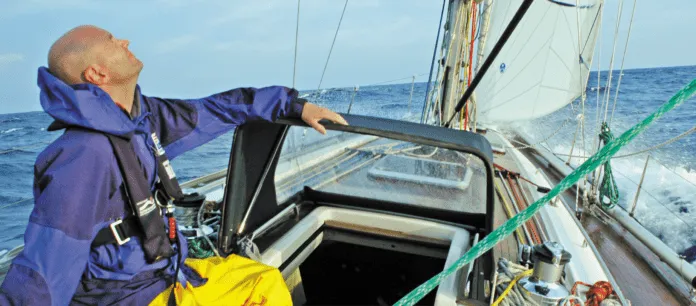
T he phrase ‘cruising canvas’ has always had a sail inventory connotation, but today it’s even more descriptive of cockpit coverings that range from small spray hoods to full cockpit enclosures.
There’s good reason to go sailing under cover. Spray protection and shielding from the sun’s harmful rays lead the list. And it’s no surprise that cruising sailors have created a booming aftermarket industry that keeps canvas lofts and stainless tube fabricators busy. The usual routine involves a canvas loft manager and a boat owner collaborating on what the boat’s designer and builder failed to address.
The results vary. When all goes well, the tubular arches and fabric structure complement the lines of the vessel, provide welcome shelter, and still preserve the ability of a crew to handle sails and move in and out of the cockpit safely. In some cases, there’s too much of a good thing, and what emerges is a Conestoga wagon-like countenance that adds way too much windage and excessive vulnerability in a seaway.
Today, more and more sailboat designers have stepped up and added dodger and Bimini plans to their original drawings. Builders are providing molded mounting points on the deck for supporting hardware that shape their dodgers and Biminis.
In this review of cruising canvas alternatives, we will focus on factors that influence design and construction as well as look into materials best suited for soft and rigid dodgers, Biminis, spray cloths and other enclosures. From the start, we recognize that one size or design won’t fit all needs. That’s why it’s so important for the skipper to communicate to the loft designer or manager what their sailing priorities are and the range of conditions that they will likely encounter.
It’s interesting to note that the less-is-more cadre of performance-oriented sailors baulk at cluttering up the cockpit with canvas that adds drag and provides no lift. They cringe at the thought of obstructing the full view of the sail plan. Those racing to Bermuda or Hawaii for example, tend to do so with minimal cockpit covering. Even so, many participants sail these races with a small, collapsible dodger that allows the companionway hatch to remain open—even when the spray is flying. When the crew is perched on the rail or working in the cockpit, they rely on hats, sun shirts, gators, glasses, and sunblock along with a good set of foul weather gear. But as this full-speed-ahead ethos devolves into the pleasure of cruising, sail area decreases and dodger and Bimini square footage increases.
At present, the independent dodger and Bimini duo is a very sensible combination regardless of whether you sail a center or aft cockpit vessel. But during the marina bound measurement process, the underway implications shouldn’t be ignored.
SAFETY CONCERNS
Unfortunately, what often goes unnoticed are the safety concerns that arise at sea. These are often linked to an excessive canvas coverup. So, when finalizing design plans, ask yourself, how watch keeping, and the helmsperson’s visibility will be affected by the proposed structure. Thanks to the ability to use clear plastic windows (vinyl, acrylic or polycarbonate), a 360-degree view can usually be maintained. It’s also important to make sure that the shortest and tallest crew members have minimal obstructions to their sightlines.
Equally as important from a safety vantage point, is the maintenance of an unencumbered pathway to and from the helm and in and out of the cockpit. All too often, larger canvas covers work just fine in calm weather, flat sea conditions and when anchored, moored, or snugged up in a slip. However, it can be a completely different story in a seaway when an awkward contortion is needed to get in and out of the cockpit.
Don’t trade big tent ambiance for an outboard detour and an elevated risk of falling overboard. In heavy weather, reefing in sail area is usually quite straight forward, but removing or folding up a large Bimini or even larger, more elaborate, full cockpit enclosure, can redline the risk meter.
Latitude and weather patterns play a big role in selection of cockpit coverings. The higher the latitude and cooler the climate, the less desire there is for shade. It’s no surprise to see a lack of Florida rooms in Norwegian fjords. But in the often rainy and overcast wonderful cruising ground in the Pacific Northwest a cockpit enclosure often mimics a trawler’s pilot house. The more sun and the lower the latitude the greater the lust for shade. And in cooler, cloudy higher latitudes, lifeline supported weather cloths can add much appreciated spray protection. However, veteran cruisers rig these spray protectors with weak, low tensile strength line, lashing the lower portion of the canvas weather cloths so that a breaking sea will not collapse lifeline stanchions. Water weighs over 8 pounds per gallon, and when hundreds or thousands of gallons of accelerated wave face contacts a large, relatively weakly supported surface area, bad things happen. In such situations, an abrupt energy transfer results in a near instantaneous collapse of the underlying structure. The larger the canvas covering, the more vulnerable it is to impacts from wind and sea.
The venerable companionway dodger is still a cruising sailor’s best friend. Its strategic role includes allowing the main hatch to remain open, even when rain is pouring down and you’re beating to windward in a blow. Its stainless steel, bow-like, arched framework and secure mounts allow it to be folded forward or pivoted up into position. When combined with a spray hood—a garage-like shelter that the main hatch slides into, a dodger can keep the companionway ladder and accommodations below quite dry, even when the spray if flying.
The traditional companionway dodger evolved and expanded into a cockpit dodger spanning the full width of the aft end of the cabin house. It turns the forward portion of the cockpit into a highly valued roost and is a good spot to sit and maintain a watch while the auto pilot or self-steering vane handles the helm. It’s attached forward, at deck level to the spray hood over the companion way hatch and to a molded deck flange specifically intended for dodger installation. The mounting hardware includes twist-fasteners and snaps that connect the canvas to the FRP surface. These fittings have proven to be quite reliable, but when poorly installed they can be the cause of severe core damage, especially in areas where Balsa wood has been used in the sandwich construction. The problem stems from drilling a hole through the outer FRP skin and not properly closing off the penetration or bedding the screw threads themselves. Over time, the fitting allows water to enter the Balsa wood and rot soon follows. Left unattended, the problem worsens, and large areas of core material can be destroyed. Newer boats are built with specific dodger mount coamings negating the need to drill holes into the cabin house itself.
In addition to expanding the dodger footprint, as time went on, zippered windows were improved, leathered handholds appeared on the trailing edge and stainless-steel grab rails made transitioning from the cockpit to the side deck safer and easier. Even so, it became clear that what works splendidly on one sailboat often fails on another. Awareness that one size or one dodger design doesn’t fit all is a major consideration. Take for example the issue of winch position, sheet leads and access in and out of the cockpit. A larger, longer dodger may hold appeal because of the shelter it provides, but if it forces those transitioning to the side decks to hobble over sheets and winches, the former advantage may be nullified by the latter’s safety implications.
In many cases the coach roof’s handrail, meant to be used by those leaving or entering the cockpit is rendered out of reach by a wide dodger. The net result is for those heading out of the cockpit to reach outboard and use the lifeline as a handhold. Modern sailboats are quite beamy aft and without a reliable handhold, getting around the dodger while entering or leaving the cockpit can be quite challenging especially in rough seas. Adding a sturdy stainless-steel tubular handrail to each side of a dodger is a big plus and worth the extra expense.
The hard dodger is hard to beat, especially when it comes to protection from the elements and the right place to stand a night watch. The best hard dodgers aren’t add-ons but were conceived by the boat’s designer. They remain structurally separated from the main accommodation and don’t eliminate traditional sliding boards and a companionway hatch or watertight door that isolates the accommodations below. There’s enough room to tuck into a cushioned seat and stay dry. And aboard larger sailboats there’s even room to stretch out. Electronic displays can be nestled under the enclosure, with a clear 360-degree field of view and you are more that half way to a pilot house but still have quick access to all the lines and sheets.
BIMINI TOPS
A Bimini is a salty term for an underway awning that usually covers more of the cockpit than a dodger. It’s a horizontal shelter that blocks sunlight and showers but lets the breeze flow through nicely. With a surface area that ranges from moderate to massive, it may be challenging to support biminis adequately. Flimsy framing may not be initially noticed but once you have weathered a significant cold front passage or a vigorous summer line squall, all of the shortfalls in support will makes themselves known. In such cases a poorly supported Bimini starts shaking like a Labrador Retriever just out of the water. The good news is that most Biminis fold up like the top of a 1969 Mustang convertible, and you can tuck things up before that front or thunderstorm threatens to unstep the support structure or shred the canvas.
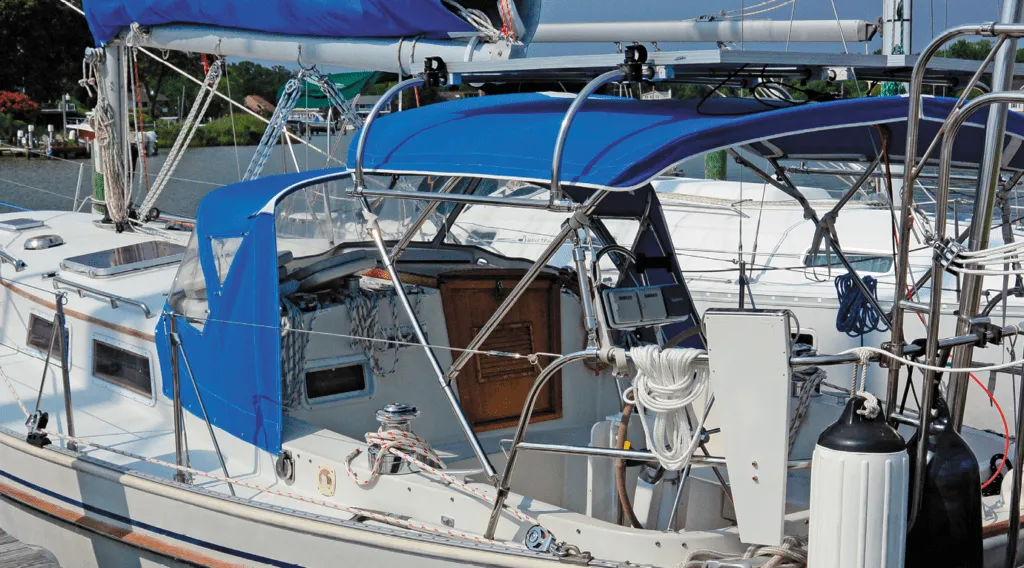
Bimini design is a challenge that engages a familiar refrain of crew comfort versus dynamics of sailing. On one hand, the lower the latitude, the more appreciated shade becomes. But sailing under cover can hamper sail trim and even raise more safety concerns because of the obstacle path presented by the support stanchions ands extra bows. Once again cockpit entry and exit is important, as is day or night usability along with design features that work in calm or chaotic seas. Is there room to drag a along a sail bag that resides in an aft locker? Quite often, the biggest design challenge lies determining the appropriate spacing between the end of the dodger and the leading edge of the Bimini. Sunlight abatement calls for a minimal gap while a sailor’s need for safe, near instantaneous sprints forward and aft demands a good-sized slot and clear access to the inboard side deck.
When it comes to Biminis, sunlight blocking is a big deal. Many sailors assume that white is a cooler color, reflects light and doesn’t heat up as much as other colors. That’s true in some cases, especially when a white vinyl top layer is bonded to a dark conventional cloth underlayer. The first dodger installed aboard my sloop Wind Shadow was just such material and it reflected sunlight and was much more opaque that Sunbrella and WeatherMax. Unfortunately, the lower layer was a mold magnet in the tropics and the use of a dilute Clorox spray soon rotted the bottom layer that provided structural support to the vinyl top layer. Since then, I’ve been happy with dark blue Sunbrella and WeatherMax.
When it comes to dodgers and Biminis, a key goal is minimizing the translucency of the fabric, and color plays a key role. The main reason why white is not the best choice in the material mentioned above is that much light penetrates the material and infrared long wave radiation bounces back and forth between the deck and the underside of the awning. This mini-greenhouse effect raises the temperature, and darker colors may get hotter on the surface but those underneath the cover will be cooler.
There’s been considerable growth in popularity of canvas cockpit enclosures (AKA Florida Room). They encompass even more canvas square footage than the dodger/Bimini combo, and usually include drape like side curtains extending down to the rail. On the upside, it maximizes under cover living space and increases shelter for those living aboard in inclement, cooler environments. Preferably, the side curtains can be unzipped, rolled up or otherwise removed, leaving what amounts to a large awning providing sunshade yet open to breezes from all directions.
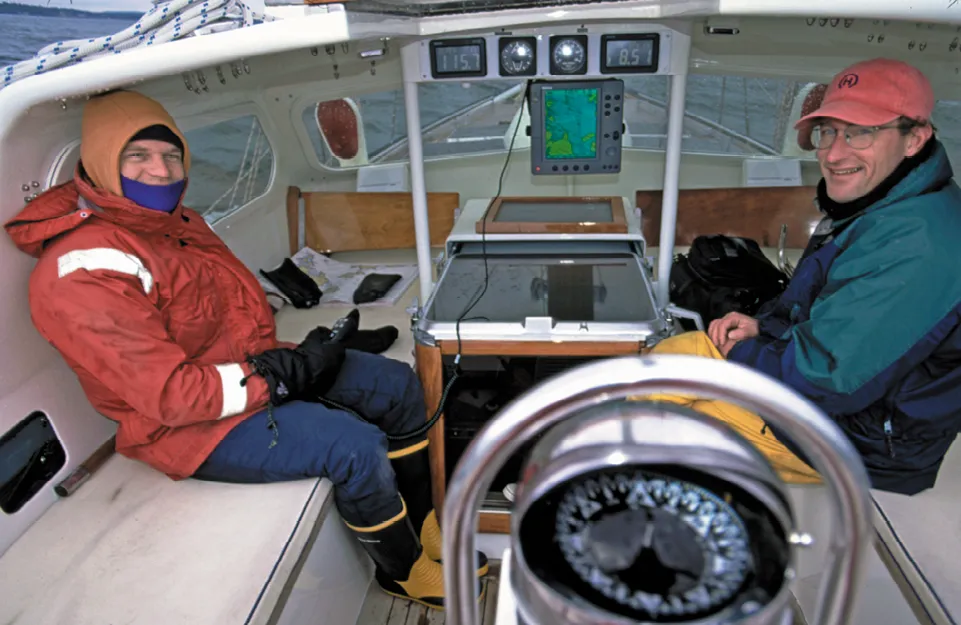
The fully covered cockpit concept has grown popular with those navigating the ICW in Fall and wintering in Georgia or Florida. The ability to make this inside passage sheltered from ocean swells eliminates the worry about being caught in rough seas and breaking waves. If you’re living aboard, the big plus is it’s like adding a second story to your house. In rainy, colder climates, the mud room is now in the cockpit rather than down below in the cabin itself. For cruising sailors who plan to harbor hop, gunkhole, or cruise in protected waters during fair-weather sailing seasons, turning the cockpit into a “Florida Room” makes sense.
The downside of this big tent approach to cockpit covering includes excess windage, diminished view of sails and in many cases, a dangerous pathway transition when heading into or out of the cockpit. However, those making a run to the Caribbean in the late Fall, face a very different challenge and must cross the fickle Gulf Stream at a very volatile time of year. In rough conditions, the best place for a big Bimini or a collapsible Florida room is stowed below in the forepeak or aft locker. Reefing sails in a Gulf Stream squall is tough enough but coping with wind and sea along with excess cockpit canvas can become a major challenge.
It’s clear that sailing in a big tent has its ups and downs. But there are some caveats. Number one is what happens offshore when you encounter a run-of-the-mill gale with 35-40 knot winds and 15-to-20-foot breaking seas? The teepee like structure in the cockpit may survive the wind, but water is 400 times denser than air and a swimming pool’s volume of sea water dropping onto the tube and fabric enclosure won’t go unnoticed.
The added windage also affects sailing performance and is likely to introduce steering characteristics that won’t appeal to the helmsperson or the auto pilot. Lastly, a good definition of “ordeal” is trying to reef the Florida Room at sea as conditions go from bad to worse. So, in your look at cover options, one of the questions to ask is, will the screened in porch-like cockpit be as cherished at sea as it is at anchor? And can it handle gale or storm force conditions?
S tainless steel tubing and hardware make up the skeleton over which fabric takes shape. The bow-shaped tubes and interconnecting clamps, joints and stanchion bases transfer dodger/Bimini loads to the sailboat’s deck. The challenge lies in creating the right combination of support for a given square footage of canvas. Keep in mind that more often than not designers and builders never envisioned a big tent over the cockpit.
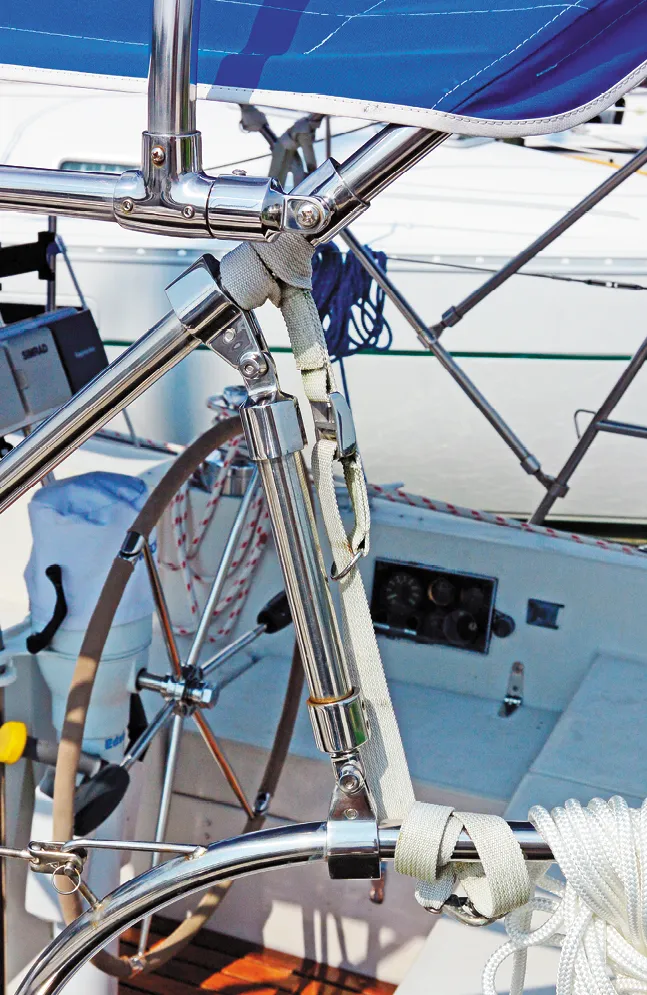
In some cases, these canvas enclosures cocoon the entire aft portion of the boat, and the underlying tubular support structure starts to look like an oil rig. Davits, solar panels, radar domes and wind generators find a foothold, and new forces are added to the equation. Add a large RIB dinghy to the davits and who knows what the result of a wave impact will be.
Smaller well-supported dodgers and fold-to-close Biminis have enough structural integrity to endure the green water impact of breaking waves. Large canvas enclosures that do a great job as rain protection in sheltered water can become a liability in a gale or storm at sea. It’s important for those making long ocean passages to be able to remove the canvas enclosures the way old time sailors struck the topsails before tangling with heavy weather.
Offshore, a different set of concerns takes priority. The most important attribute of a cockpit covering is its ability to stand up to the adversity of wind and sea. Wave top spray is only the start. It’s the plunging breakers or leeward impact of a bad broach that can add an unanticipated load to gossamer tube and canvas covers.
Years ago, I ocean raced with Eddie Greeff and Rod Stephens aboard Eddie’s classic 47-foot S&S called Puffin . On one off watch chat, Eddie spoke of a Mistral in the Med and the problems that arose aboard his previous forty-footer also named Puffin. It all began when a breaking wave tossed the boat to leeward and the impact with green water sheared a portion of the coach roof allowing the sea to cascade below. Heaving to and quick damage control efforts by an experienced crew saved the vessel.
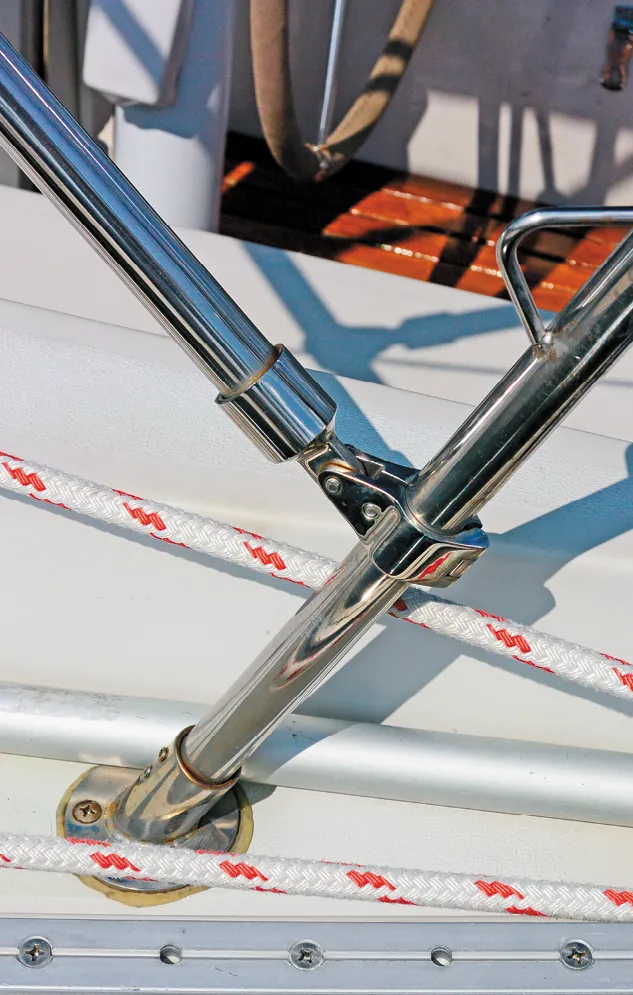
All I could imagine was what would have happened to a dodger or Bimini of even larger cockpit enclosure in such conditions. Some years before, my wife and I and our children were sailing across the Tasman Sea and were caught in storm force conditions. A breaking wave crushed the dodger and cracked a Lexan storm cover on a cabin port. The point here is that one should look at cockpit covers in context with the seas being sailed.
T here are probably more varieties of dodgers as there are boats. Here is a quick overview of the various details to consider in your own cockpit canvas.
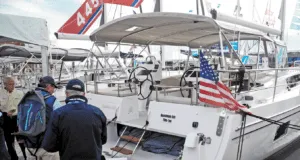
1. Wide cockpit, modern designs vastly increase Bimini and dodger surface area. Multiple support bows are needed. Windows in the overhead must provide good visibility for sail setting, reefing, and trimming on all points of sail.
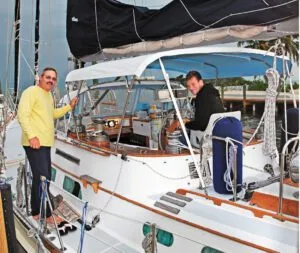
2. In warmer more friendly latitudes, sun rather than breaking waves is the culprit. A Bimini with a two layer vinyl (white) and polyester (blue) fabric reflects light. Mold resistance also is improved.
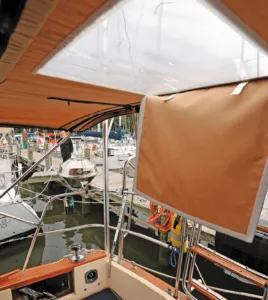
3. Windows in Biminis are a must if sail trim and setting is a priority. Closing up the flap when not on board can prevent puddled rain water from acting as a lens, refracting light and causing damage to sailing instruments.
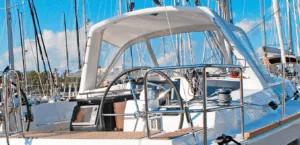
4. Many new cruising boats add fiberglass structures that support dodger canvas. With an autopilot remote control inside the dodger, watch standers have both weather protection, helm control and full visibility
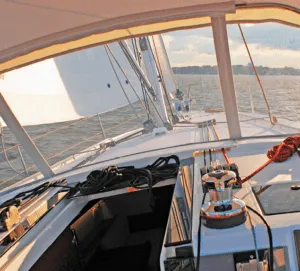
5. A good dodger allows for winch work, provides shelter and allows a crew to pop out and have easy access to sheets, guys and especially the helm. Keep glazing clear (see “ Long Term Clear Vinyl Protection ,” PS November 2018).
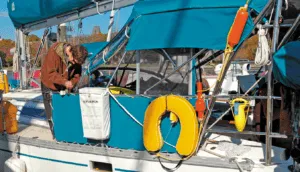
6. Spray cloths, a big Bimini and side curtains plus an array of safety gear can become the targets of a breaking sea. It’s important to rig covers and safety gear in keeping with the cruising conditions.
RELATED ARTICLES MORE FROM AUTHOR
Leave a reply cancel reply.
Log in to leave a comment
Latest Videos
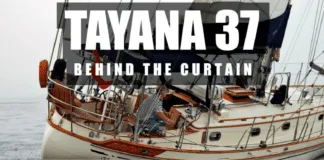
Tayana 37: What You Should Know | Boat Review

Monitor Your Whole Boat From Home On A Mobile App

Beneteau 423: What You Should Know | Boat Review

Buying A Sailboat Is Scary! Yacht Broker Interview
- Privacy Policy
- Do Not Sell My Personal Information
- Online Account Activation
- Privacy Manager

- $ 0.00 0 items
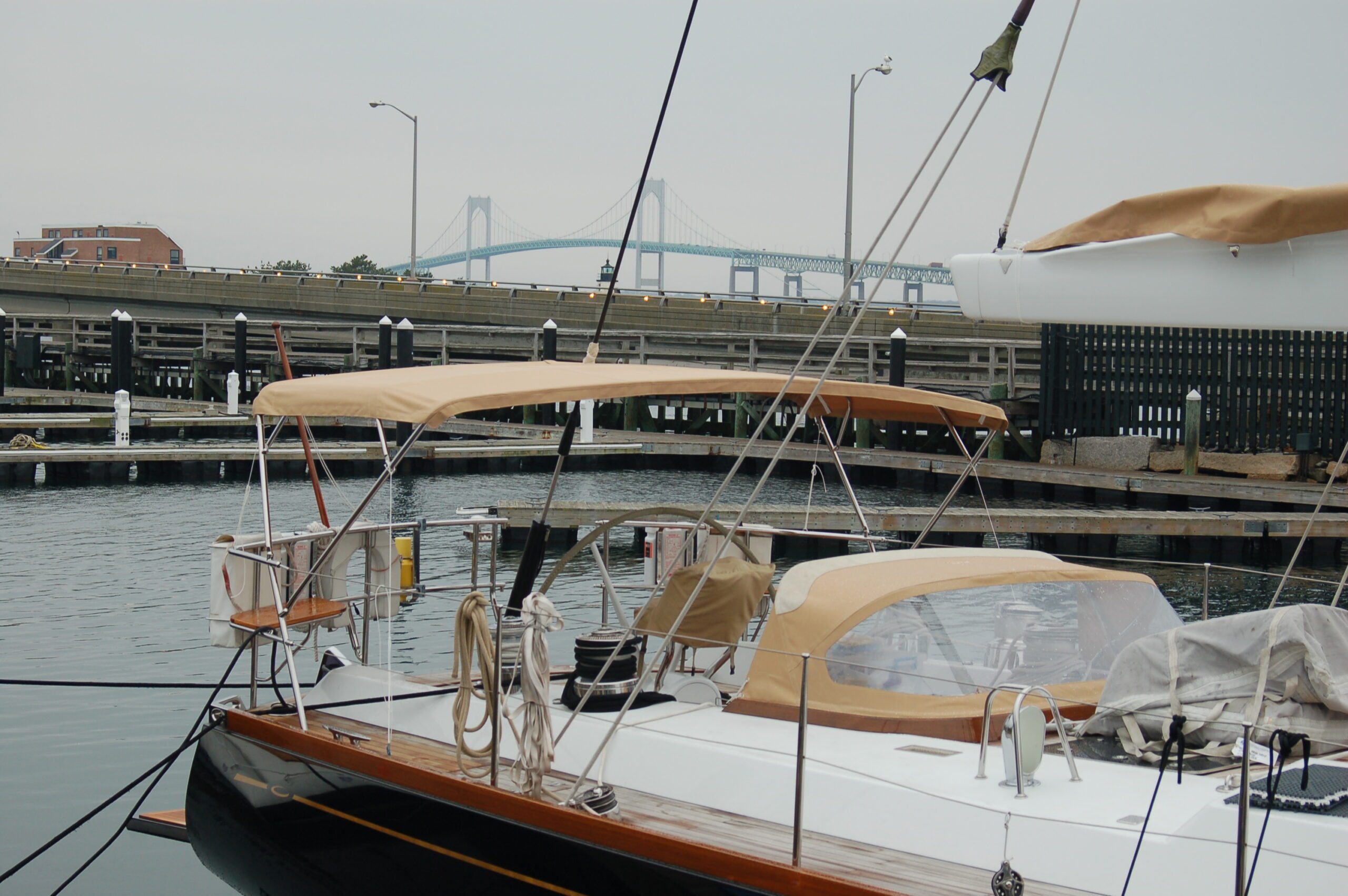
The harsh elements of New England weather not only do a number on your boat, but also can leave you and your crew ravaged, as well. Our custom fitted dodgers for your boat are rugged and UV resistant, providing cover from wind, rain, sea spray, and the intense summer sun. A dodger allows you to comfortably remain on deck in inclement weather, and lets you enjoy fair weather without turning into a boiled lobster.
Showing all 16 results
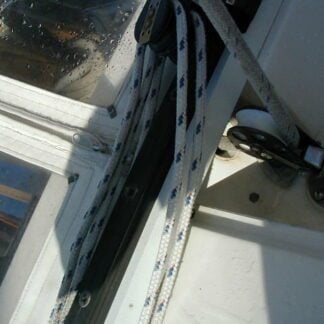
Alden 44 Dodger
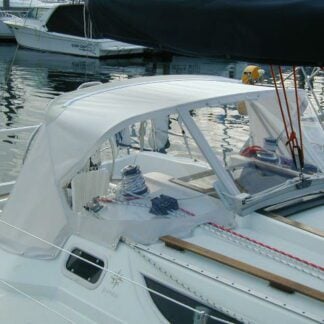
Berthet Dodger
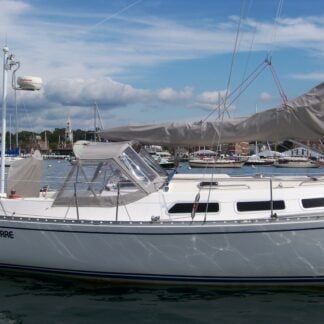
Chapman Dodger
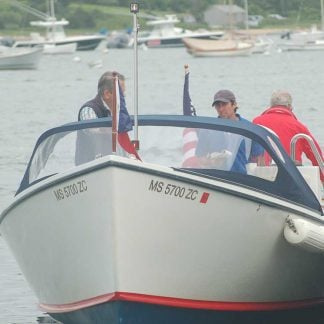
Custom Dodger
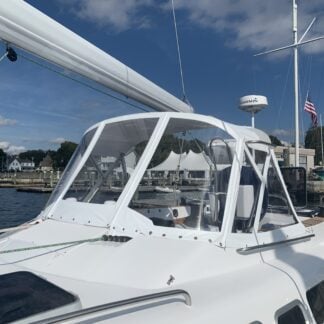
Custom Freedom 45 Dodger
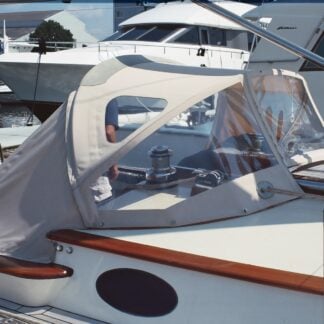
Friendship Dodger
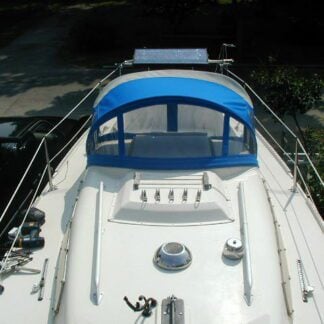
Hotchkiss Dodger
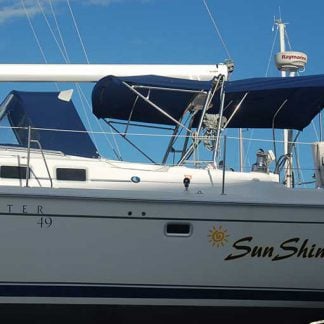
Hunter 49 Dodger
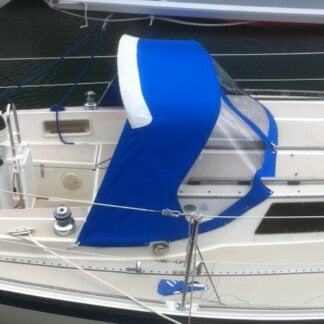
O’Day Dodger
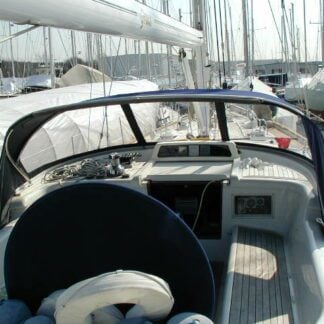
Oyster Dodger
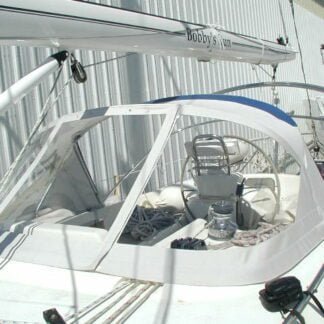
Pratt Dodger
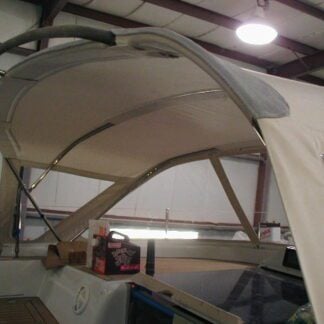
Starr Trial
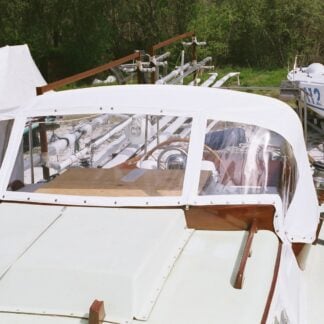
Wauquiez 43 Pilothouse
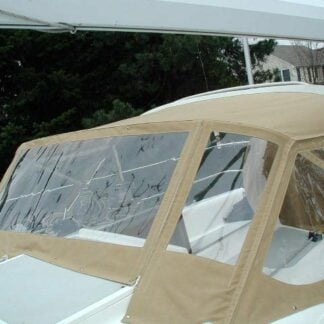
Winderman Dodgers
- Biminis & Awnings
- Sheetbag Products
- Electrical Box Cover
- Soft Sided Dock Boxes
- Premium Dock Boarding Mats
- Gunnel Boarding Mats
- Dinghy & Tender Covers
- Wheel Covers
- Lifeline Covers
- Cockpit Enclosures
- AERÉ Inflatable Fenders
- AERÉ Inflatable Fender Covers
- KI Pro Flat Fenders
- Premium Fender Covers
- Fender Covers
- Custom Fenders
- Hinged Flat Fenders
- L - Shaped Fenders
- Grand Prix Duffle Bags
- Trophy Bags
- Tool Organizers
- Chair Covers
- Custom Upholstery
- UFO Foiling Dinghy
- Alden Sakonnet
- Catalina Dinghy
- Dyer Dink 10
- Flying Junior
- Flying Scot
- Hunter Liberty
- Laser Bahia
- Puffin 10.6
- Tech Dinghy
- Vanguard 15
- Vanguard 49er
- Vanguard Nomad
- C&C Redline 41 (2014)
- One Design 35
- Melges IC37
- Stur-dee Cat
- Alerion Express 20
- Alerion Express 28
- Catalina 320
- Herreshoff S Boat
- Sea Sprite 23
- Ultimate 20
- Atlantic 30
- Herreshoff 12 1/2
- Nacra Carbon 20
- Nacra Inter 17
- Bimare F18 HT
- Blade F16 Covers
- Capricorn F-18
- Corsair Sprint 750 Covers
- Falcon F-16
- Falcon F-18
- Hobie FXOne
- Hobie Getaway
- Hobie Miracle 20
- Hobie Tiger
- Hobie Wildcat
- Marstrom 32
- Nacra F-18 Infusion
- Nacra Olympic 17
- Weta Trimaran Yard Cover
- Nacra 18 Square
- Nacra Inter 20
- HH Catamarans
- Custom Yachts
- Deck Chair Cushions
- Interior Cushions
- Custom Yacht Interiors
- Small Powerboat Cushions
- Powerboat Covers
- Sailboat Covers
- Ocean 1 Yachts
- Sportsman Powerboats
- Boston Whaler
- Grady White
- Hydra-Sport
- Mainship Trawlers
- Parker Boats
- Sailfish 290 CC Winter Cover
- Tiara Yachts
- Camper and Nicholson
- Island Packet
- Pacific Seacraft
- Pearson Yachts
- Nautor Swan
- Sabre Yachts
- Tartan Yachts
- Sail Shades and Tension Structures
- Industrial Canvas
- Sail Shades
- Commercial and Store Front
- Custom Architectural Canvas
- Recent Projects
- Kinder Safety Supply and PPE Materials
- Throw Pillows
- Winter Cover
- Kinder Safety Supply
- Marine Grade Sunbrella
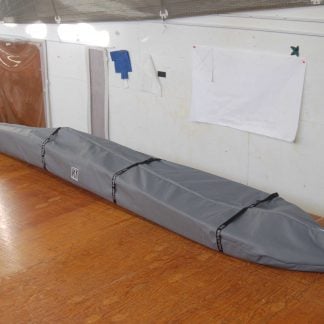

IMAGES
VIDEO
COMMENTS
The plywood panels can then be assembled by stitching them together with monofilament line. Drill small holes near the edges of connecting panel sides and then use these for running the line. This is a very low-tech and forgiving process, as later this will all be covered by filler, fiberglass tape and epoxy.
Two boat owners came over last weekend and checked out the new dodger. Both seemed to love it. If you have any customers with double enders send'em my way! If you're looking for a dodger that provides aesthetics, strength and functionality, think TARTAROOGA! dodgers Looking for a combo that provides a reliable….
To put this in perspective, you might not want a hard dodger if your boat is relatively cheaper. If you have a $100,000 sailboat, or simply want to improve the value of your current one, it might make sense to protect your investment with a hard dodger. ... Small Sailboat Sizes: A Complete Guide. Daniel Wade. October 30, 2022. Popular Posts ...
The Super-compact Sailboat Dodger. John Stone and Far Reach sail toward a squall line during a homeward passage from St. Martin to North Carolina. This first pram-hood, which offered modest protection from rain and spray, was later upgraded to a larger design. Sailing in general, but especially offshore, can sometimes be a wet experience ...
Hardtop Dodger: The actual hardtop is fabricated with a ¾" foam or balsa core, x-mat fiberglass, epoxy resin and high quality gel coat. It is a 3 inch cambered 90" x 54" x 1" top with a rain lip. Because of these features, The hardtop is very strong, robust and provides a durable surface allowing you to mount solar panels, lighting ...
The answer was a mini-dodger fabricated from a sheet of fiberglass shower-liner material. It snaps into the slider grove in seconds, and by virtue of being cut slightly wider than the opening, it flexes into a cone-shaped arch, tapering down to nothing at the forward end of the slider and providing a small overhang on the cockpit end.
A DIY step-by-step tutorial on how to build a hardtop for a boat.Refitting Atticus took us 3 long years, during which time it was difficult to decide what we...
Include both fixed and opening lexan/plexi windows on the front and sides. Add high and how grab bars to the sides. Some sort of mechanism to attach a sunbrella/eisenglass connector from dodger to bimini that doesn't leak rain. Rain gutter or shape it to guide rain to the sides away from companionway. Be lightweight.
This week's episode captures us building our new hard dodger out of PVC foam and fiberglass. KEEP US SAILING!Support us and gain early access to videos and o...
From the creators of "Tower in a Box" Sail Arch and Super Sail Arch A unique "made measure" hard dodger hardtop system. ONLY $5500 complete with supporting structure and base fittings for Dodgers up to 50 square feet larger sizes available. Stay dry with it. Standard equipment canvas rail fitted up and under the top perimeter is standard.
who we are. A little history: tartarooga goes back to 1977, Jacques built the first hardtop dodger for his sailboat. It was a Dragon Class sloop, a sleek racer. The purpose was to keep the boat's dog, Mister Eddy, out of rain and spray. The first incarnation of our hardtop dodger became quite popular among Dragon racers.
Hardtop Dodger Specifications: If you are in the market for new Hardtop Dodger, call The Canvas Works @ 415.331.6527 or inquire now. Get an Estimate. Get a Hardtop Dodger for a better offshore experience! Low maintenance with a strong, dependable surface to mount solar panels or hardware.
Normally used to panel bathrooms, these handy 4.5 x 8.5ft sheets aren't especially strong, but they're wonderfully flexible, and I was able to bend them around the outboard ends of my dodger frame. On one side the panels are smooth, on the other, they are textured. I made templates, cut out the pieces with a jigsaw, and clamped the first ...
The "Road Crew" at Iverson's is on the go, constructing dodgers on sailboats of all makes and styles between Portland, Oregon and Washington. With their efficient design and manufacturing methods you can have a new custom canvas dodger in as little as a week*. *Please note that the Iverson's Dodger waiting list can be 2 to 4 months out, upon ...
In this video we shove you the start of our project to change from fabric dodger to hard dodger. It's not an instruction video just how we did it.Maybe it ca...
Re: Hard Dodger (Sprayhood) Illustrated Guide - Examples, Tips. Steady, There are times and situations where a hard dodger would not be desireable. When docking in close quarters it's nice to be able to lower the dodger for a better view. And when mooring the boat in a location where the stern will face winds such as a bora or mistral.
I am building a hard dodger for an O'Day 35, I want to move the traveler from the deck forward of the companionway to the aft end of the dodger-out of the way. The main arch at the very rear which will be the load bearing part, has a base (entire top ) of 1/2″ cell modulus (NICORE) with one layer of fiberglass matting on the bottom and ...
Example #1 SVERIGE Boat = Bristol 40 Yawl 1970 Hard Dodger Custom Build This boat SVERIGE has a hard dodger. I asked the owner about that dodger and how much it cost to fabricate or purchase.Here is his reply: SVERIGE Owner: "It took me 80hrs. A Trojan 32ft fish boat with a fly bridge. Used cored flybridge deck and about 20ft hull plate midships. It's solid composite with green Solex Laminated ...
Current position: Lat: 8.910629 Lon: -79.525725If you want to support me, check out my Patreon account (thank you so much!!) patreon.com/windhippieFor more r...
A small folding hatch dodger keeps spray out of the cabin, minimizes windage and inevitably soaks the crew. ... The best hard dodgers aren't add-ons but were conceived by the boat's designer. They remain structurally separated from the main accommodation and don't eliminate traditional sliding boards and a companionway hatch or watertight ...
Join Date: Jul 2014. Posts: 6,103. Re: Hard Dodger (Sprayhood) Illustrated Guide - Examples, Tips. Hard Dodger Design #12. Notice the white hard top, the clear glass and the dark framing of the glass and a split middle window (probably a drop down panel for ventilation). Attached Thumbnails.
Use a small pilot drill first - if you miss the right spot, you can easily fill an unwanted hole with epoxy. Once you hit the right spot, drill the dodger and the fitting for a bolt (I used 3/8" 316 SS bolts of the appropriate length). 29. Now that the bolts are holding the fittings in place, you can create a bed for the fitting on the dodger.
Our custom fitted dodgers for your boat are rugged and UV resistant, providing cover from wind, rain, sea spray, and the intense summer sun. A dodger allows you to comfortably remain on deck in inclement weather, and lets you enjoy fair weather without turning into a boiled lobster. Showing all 16 results.